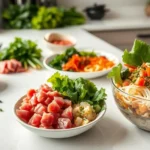If you’re searching for the perfect balance between healthy eating and mouthwatering flavor, poke bowls are exactly what you need. Originally from Hawaii, the poke bowl has taken the culinary world by storm, offering a refreshing mix of fresh seafood, crisp vegetables, hearty rice, and bold sauces—all in one colorful, customizable dish. Whether you’re a seafood lover or prefer plant-based options, there’s a poke bowl combination just waiting for you.
What makes poke bowls so popular? It’s the endless variety! From traditional ahi tuna poke to creative twists featuring tofu, shrimp, or spicy salmon, each bowl is a personal masterpiece packed with nutrients and taste. Plus, with the growing trend of healthy eating, poke bowls have become a go-to meal for anyone looking to enjoy something both wholesome and satisfying.
Ready to dive into the flavorful world of poke bowls? In this guide, we’ll explore everything you need to know—from choosing the best ingredients to building a bowl that matches your style. Whether you’re a first-timer or a seasoned poke fan, get ready to be inspired and hungry for your next bowl of goodness!
Key Takeaways
- Discover the Hawaiian origins of this customizable dish
- Master essential factors like sushi- grade fish and seasoned rice
- Combine textures with vegetables, edamame, and brickle condiments
- produce balanced flavor biographies using soy sauce and sesame oil painting
- Follow expert safety tips for handling raw proteins
- acclimatize fashions for salutary preferences or seasonal constituents
preface to Poke Bowls
Before various coliseums filled social media, Native Hawaiians made a simple yet scrumptious dish. Called” POH- keh”, this traditional Hawaiian dish started as a snack for fishers. It’s now a artistic fave, celebrating the islets’ seafood.
From Ocean to Table The Origins
Early performances used small reef fish or octopus. Japanese emigrants brought ahi tuna and soy- grounded gravies in the 19th century. This blend created the bright, savory flavors we love moment. Raw fish stayed crucial, but new styles came from around the world.
ultramodern Appeal Meets Ancient Roots
moment’s poke coliseum mode is about health, looks, and making it your own. People enjoy mixing sushi- grade proteins, crisp veggies, and creative gravies. Cookers now use quinoa or kale rather of rice, showing the dish’s inflexibility.
caffs far and wide love its rigidity. A single coliseum can have tuna or salmon with healthy condiments. This blend of old and new keeps the dish instigative, from deepwater spots to megacity lunch places.
Essential constituents for a Traditional Poke Bowl
Authentic Hawaiian cookery starts with crucial constituents. It has three main corridor perfect rice, top- notch proteins, and bold flavors. Each part works together to give the dish its unique taste and feel.
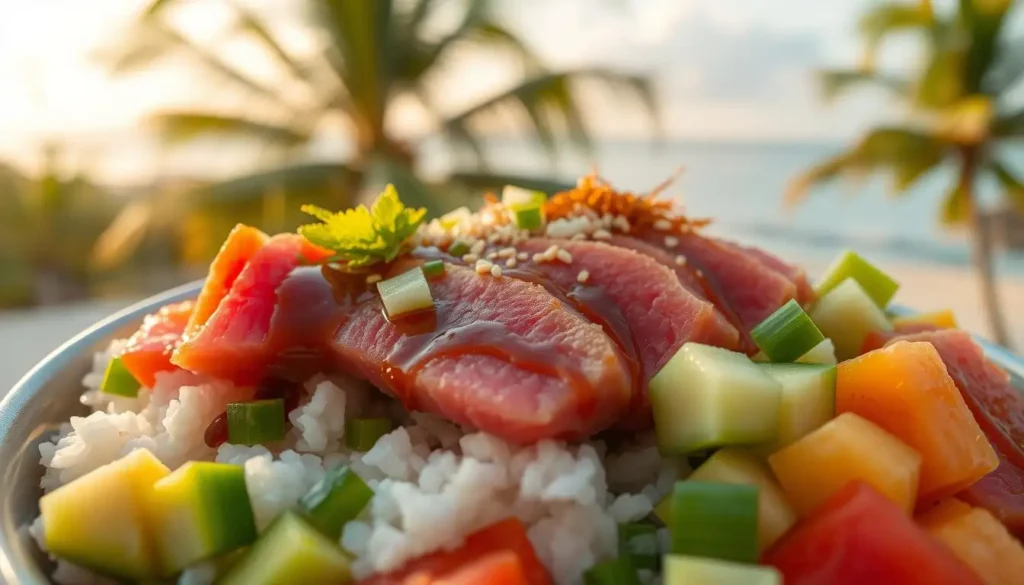
Core Elements: Rice, Fish, and Marinades
Sushi rice is the base, with a hint of agreeableness. It’s seasoned with rice ginger for the right stickiness. For proteins, sushi- grade ahi tuna or salmon is used for its rich flavor.
Gravies blend soy sauce, sesame oil painting, gusto, and garlic. They tenderize the fish and add depth. A 30- nanosecond soak lets flavors soak in without overpowering the fish.
Beating Options and nutritive Benefits
Crisp veggies like cucumber add fiber. Avocado brings healthy fats. Edamame boosts factory- grounded protein, and sesame seeds add calcium. Traditional setoffs include seaweed and green onions for a savory kick.
ultramodern twists might add mango for agreeableness or sriracha mayo for spice. Each beating adds to the dish’s look and nutritive value, making every bite healthy and delicious.
Discovering Popular Poke Bowl Variations
When traditional dishes meet global flavors, cookers produce new prodigies. They keep the dish’s substance while trying new effects. This blend of old and new makes moment’s poke coliseums instigative.
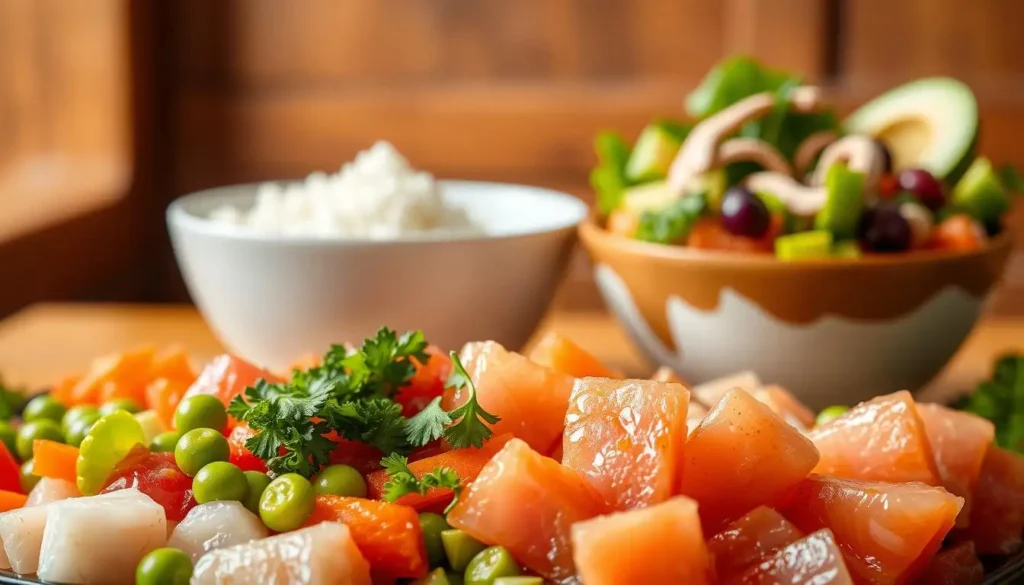
Traditional Hawaiian Style vs. Modern Twists
Classic poke coliseums are simple sushi- grade tuna marinated in soy and sesame oil painting over rice. Seaweed and green onions add earthy flavors. ultramodern performances might use seared salmon or add mango for agreeableness.
Avocado and crushed macadamia nuts add delicate and brickle textures. Kimchi- invested coliseums show Korean faculty, while vegan options use tofu. These changes keep the dish fresh and scrumptious with quality constituents.
Creative Flavor Combinations
Texture is crucial in ultramodern poke coliseums. crisp shallots and silky ahi tuna make a great discrepancy. Pickled gusto cuts through rich gravies. Cookers subcaste two dressings, like racy mayo and citrus ponzu, for depth.
Global flavors shine in dishes like shrimp with coconut- lime dressing or teriyaki- glazed tofu. Edamame adds protein, and quinoa backups boost fiber. This inflexibility makes every coliseum both familiar and instigative.
Ready to make your own? The coming section will guide you in making eatery- quality refections at home.
Step- by- Step companion on Casting Your Poke Bowl
Creating a memorable mess is each about perfection and creativity. Follow these way to subcaste flavors and textures like a pro. Make sure to keep food safety in mind.
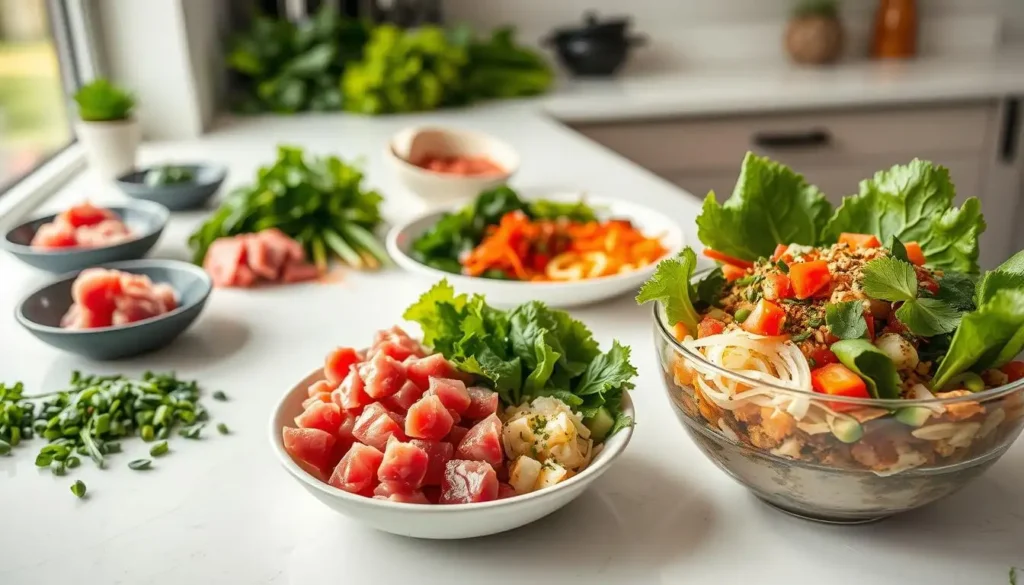
Preparation: Cutting, Marinating, and Cooking Rice
Start with sushi rice. wash it until the water is clear to remove brio. Cook it with a 11.25 rice- to- water rate for the right stickiness. Season it with rice gusto while it’s warm for a balanced taste.
For raw fish, use a sharp cutter to cut sushi- grade ahi tuna into ½- inch cells against the grain. Mix soy sauce, sesame oil painting, diced gusto, and garlic for the condiment. Gently toss the fish and chill for 15 twinkles. Do not marinate too long, as it can break down the proteins.
Assembly ways and Serving Suggestions
Start with warm rice as the base, also add stupefied fish. Arrange avocado slices and cucumber lists radially for a nice look. Sprinkle sesame seeds and scallions unevenly across the dish.
mizzle gravies last to help stuffiness. Cook Hiroshi Yamamoto says,” Treat each element like art — place condiments designedly.” Serve incontinently to keep temperature contrasts.
Double the form by preparing constituents in batches. Store leavings independently marinated fish lasts 24 hours in the fridge. Keep all components chilled below 40°F until serving to ensure food safety.
Exploring Different Protein and Sauce Options
The key to indelible flavors is quality proteins and bold gravies. Whether you prefer oceanic newness or factory- grounded options, smart negotiations let you knitter refections to your taste. This way, you recognize the dish’s substance.
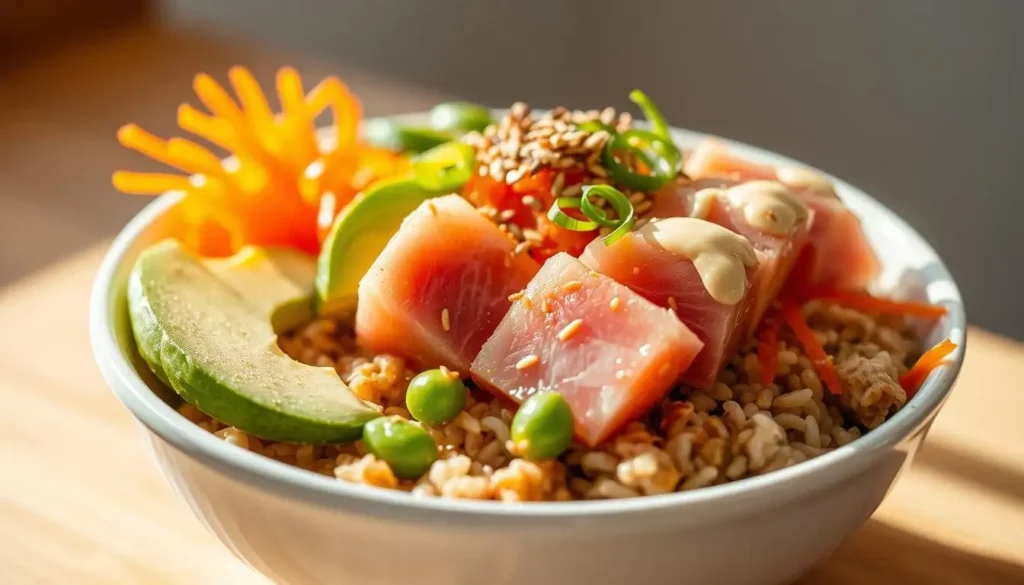
Protein Powerhouses Beyond Tradition
Sushi- grade ahi tuna is the gold standard for its caloric texture. For richer flavor, try salmon marinated in citrus- soy composites. Insectivores can use firm tofu or tattered funk for spare protein. Always stroke proteins dry before seasoning to insure gravies cleave duly.
Sauce Casting Made Simple
Master three rudiments for name gravies acidity( rice ginger), umami( soy sauce), and aroma( heated sesame oil painting).A introductory seasoning mixes 2 tbsp soy sauce, 1 tbsp sesame oil painting oil, and 1 tsp grated ginger. For heat, add sriracha. For agreeableness, mix in honey.
Cook Lana Matsumoto recommends” Brace delicate fish with light gravies like ponzu. Heartier proteins shine with delicate dressings — suppose racy mayo on seared tuna.” Always taste- test dressings before adding to avoid overpowering fresh constituents.
Keep raw fish refrigerated at 40°F or lower until it’s ready for use. To ensure food safety, always marinate proteins in the refrigerator and consume them within 24 hours. trial with heated sesame seeds or avocado slices to add differing textures without complicating fix.
Customizing for Dietary Needs and Preferences
Salutary restrictions do n’t have to limit culinary creativity thanks to adaptable dishes. By switching crucial constituents while conserving bold flavors, you can draft refections that satisfy both taste kids and nutritive conditions.
Factory- Powered Twists
For submissive or vegan fashions, marinated tofu is a star. Press establishment tofu to remove humidity, also cell it. Toss in a sauce of soy( or tamari for gluten-free) and rice ginger.
Brace it with avocado slices, cucumber lists, and roasted nuts for crunch. Cook Elena Park says” Texture balance is crucial — add edamame for protein and pickled gusto for brilliance.”
Low- Carb & mislike-Friendly Options
Keto suckers use cauliflower rice or spinach rather of rice. Gluten-free options use coconut aminos rather of soy sauce. Both benefit from
Brickle condiments like sesame seeds or crushed macadamia nuts
Extra vegetables similar as radishes or spiralized zucchini
Delicate dressings made with tahini or Greek yogurt
While traditional coliseums use sticky sushi rice, fumed kale or tattered cabbage adds bulk. Anticipate brighter flavors from citrus- marinated proteins and varied textures. Always check markers for retired gluten in gravies or seasonings.
Sourcing Quality constituents and Food Safety Tips
Memorable dishes begin with thoughtful preparation. Selecting the right decorative elements can transform a simple meal into something extraordinary. When working with raw seafood, prioritizing quality is essential for both exceptional flavor and safety.
Choosing Sushi- Grade Fish and Fresh Produce
Sushi- grade markers are important. This means the fish was firmed at-31 °F to kill spongers.Choose pieces with vibrant, firm flesh and a fresh, clean scent.. Trusted places like Whole Foods or original seafood requests offer clear sourcing.
make your constituents list with these rudiments
Short- grain rice for ideal stickiness
Crisp vegetables( cucumber, radish)
Heated seaweed or sesame seeds
Fresh sauces like cilantro or green onions
Safe running and Storage Practices
Keep raw salmon or tuna below 40 °F until use. Marinate in the fridge — noway at room temperature. Cook Marco Rodriguez advises” Treat raw fish like milk.However, do n’t risk it with seafood, If you would n’t leave dairy on the counter.”
Store leavings in watertight holders for over to 24 hours. indurate unused portions incontinently if not eaten within a day. Always separate gravies for raw proteins to avoidcross-contamination.
Quality constituents ameliorate both flavor and safety. Making informed choices turns home kitchens into epicure spaces where every bite is a delight.
Conclusion
Casting your perfect mess starts with recognizing traditional Hawaiian roots while being creative. Every great poke coliseum form balances sushi- grade proteins like ahi or salmon with pungent gravies. Add crisp vegetables, delicate avocado, and nutty sesame seeds for texture and nutrition.
Success in making poke coliseums comes from quality constituents and careful assembly. Marinate tuna poke right, subcaste condiments courteously, and always prioritize food safety. You can acclimatize fashions to fit salutary requirements — exchange proteins, try different dressings, or use edamame for factory- grounded protein.
Your kitchen is a place to explore flavors. Partake your creations with others, and flash back eatery- quality refections come from fresh constituents and a bold spirit. Let each bite celebrate the dish’s heritage while showing your unique taste.
FAQ
What defines a traditional Hawaiian poke coliseum?
A classic poke coliseum has sushi- grade ahi tuna, soy sauce, and sesame oil painting over white rice. It’s outgunned with Maui onions, green onions, and inamona( roasted kukui nuts) for real flavor.
Can I use cooked proteins rather of raw fish?
Yes! Grilled shrimp, teriyaki funk, or ignited tofu are great options. Marinate them in ponzu or racy mayo for redundant taste.
How do I insure my fish is safe for raw consumption?
Look for fish labeled “ sushi- grade ” from dependable sources. indurate it at-4 °F(- 20 °C) for 7 days to kill spongers. also, keep it cold until you are ready to eat it.
Are there low- carb druthers to rice?
Try cauliflower rice, zucchini polls, or mixed flora rather of white rice. These choices fit keto or paleo diets and add crunch and newness.
What gravies brace stylish with salmon coliseums?
Delicate wasabi- lime dressing or yuzu- miso glaze are great with salmon. For lighter flavors, use rice ginger with gusto or citrus ponzu.
How long can marinated fish sit before serving?
Marinate ahi tuna or salmon for 15 – 30 twinkles. Do not marinate it for further than 2 hours, as it can lose texture, substantially with acidic constituents like lime juice.
Can I make vegan performances taste authentic?
Yes! Use marinated watermelon or beet cells as “ tuna ” backups. Add avocado, edamame, and pickled radish. also, mizzle with coconut aminos or tamari for umami.
What condiments add crunch without overpowering flavors?
crisp garlic chips, heated sesame seeds, or macadamia nuts add crunch. smoothly pickled vegetables like carrots or daikon also balance delicate rudiments.
Fresh Ahi Tuna and Salmon Poke Bowl
Equipment
- Bowl (for serving)
- Sharp knife (for cutting sashimi-grade fish)
- Mixing bowl (for marinating fish)
Ingredients
- 200 g sashimi-grade ahi tuna diced
- 200 g sashimi-grade salmon diced
- 1 cup cooked sushi rice
- ½ avocado sliced
- ½ cucumber thinly sliced
- 2 tablespoons soy sauce
- 1 tablespoon sesame oil
- 1 tablespoon sriracha mayo
- 1 tablespoon pickled ginger
- 1 teaspoon sesame seeds
- 2 tablespoons chopped scallions
Instructions
- Dice the ahi tuna and salmon into bite-sized cubes.
- In a mixing bowl, combine the fish with soy sauce and sesame oil. Gently toss to coat.
- Prepare serving bowls by adding a base layer of sushi rice.
- Arrange the marinated fish, avocado slices, cucumber, and pickled ginger over the rice.
- Drizzle with sriracha mayo and sprinkle sesame seeds on top.
- Garnish with chopped scallions and serve immediately.


